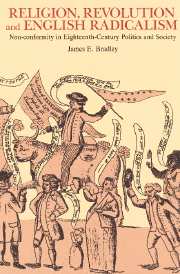 Religion, Revolution and English Radicalism
Religion, Revolution and English Radicalism Published online by Cambridge University Press: 29 October 2009
The use of occupations for electoral and social analyses in eighteenth-century studies has taken a major step forward in the past decade. The five-fold classification utilized first by T. J. Nossiter, and subsequently by Thomas Knox, John Phillips, and Frank O'Gorman is now so well established, that if one wishes to contribute to comparative studies, one is compelled to adopt it. But there are good theoretical as well as pragmatic reasons for utilizing this classification that have not heretofore been made sufficiently explicit. This appendix attempts to advance the discussion by analyzing the tables of Joseph Massie and by reconsidering the classification of specific occupational labels, especially at the middling level.
In this project, 456 different occupational labels were encountered in the Anglican registers, non-parochial registers, petitions, and poll books. The historian who wishes to utilize such occupational data for the purpose of social analysis is confronted at the outset by two notoriously difficult problems. First, one must settle upon a small number of general occupational categories that can be related convincingly to social structure. Second, hundreds of specific occupations must be subsumed under half-a-dozen or so occupational categories. The question of occupational categories as indicators of wealth has recently received a great deal of attention, and there appears to be a growing consensus that such categories as merchant, tradesman, and artisan, may be validly used to classify people in terms of wealth and social status.
To save this book to your Kindle, first ensure no-reply@cambridge.org is added to your Approved Personal Document E-mail List under your Personal Document Settings on the Manage Your Content and Devices page of your Amazon account. Then enter the ‘name’ part of your Kindle email address below. Find out more about saving to your Kindle.
Note you can select to save to either the @free.kindle.com or @kindle.com variations. ‘@free.kindle.com’ emails are free but can only be saved to your device when it is connected to wi-fi. ‘@kindle.com’ emails can be delivered even when you are not connected to wi-fi, but note that service fees apply.
Find out more about the Kindle Personal Document Service.
To save content items to your account, please confirm that you agree to abide by our usage policies. If this is the first time you use this feature, you will be asked to authorise Cambridge Core to connect with your account. Find out more about saving content to Dropbox.
To save content items to your account, please confirm that you agree to abide by our usage policies. If this is the first time you use this feature, you will be asked to authorise Cambridge Core to connect with your account. Find out more about saving content to Google Drive.